#R. C. Sherriff
Explore tagged Tumblr posts
Text

Greengates by R. C. Sherriff published 1936. It is the story of Thomas Baldwin who retires after 40 years and suddenly finds himself and his wife in the uncharted landscape of retirement. Surprisingly I haven’t seen retirement addressed so directly in fiction before. In fact , I thought the most interesting part of the book was the phase of bewilderment of the newly retired couple. The story made me consider how often partners know so little of each other’s daily routines and responsibilities during the working years and how this can make the transition to retired life together a difficult one. The resolution of their difficulties is well done but comparatively mundane and predictable. Overall I thought it was a good story, and my rating is 3/5.

1 note
·
View note
Text

JOMP BPC - 4th June - Away from Home
This is a lovely novel about a family who go away on holiday together. That's it, really. Nothing very dramatic happens, but it's a sweet, gentle read about ordinary people doing ordinary things. That might sound dull, but it really isn't. It's set between the two world wars and it portrays the kind of safe, stable domestic life that people longed for during the first world war. The book's published by Persephone Books, and their books are always lovely objects as well as being enjoyable to read.
6 notes
·
View notes
Text
the two books i've read in the last week are Nova by Samuel Delaney and The Hopkins Manuscript by R. C. Sherriff and i would recommend both of them! i'm a massive sci-fi fan so nova was really fun, the characters were all super engaging and i was a big fan of the protagonist mouse - and the hopkins manuscript actually made me cry a little, it was a really good picture of humanity. you can really tell it was written in the fear of a second world war, i found it really moving.
would definitely recommend - if anyone has some recs for me for what to read next i'd love that! Jennifer Saint's Elektra is on my list, as well as The Hobbit and The Silmarillion, but other than that i'm running out of books i have with me and will need to go get some more
0 notes
Text
In Memoriam and Journey's End
Readers of In Memoriam! I don't know how many of us have read R. C. Sherriff's Journey's End, but having studied it ages ago at school and seeing it in the Historical Note, I decided to give it a reread and noticed LOADS of similarities, these ones in particular stuck out:
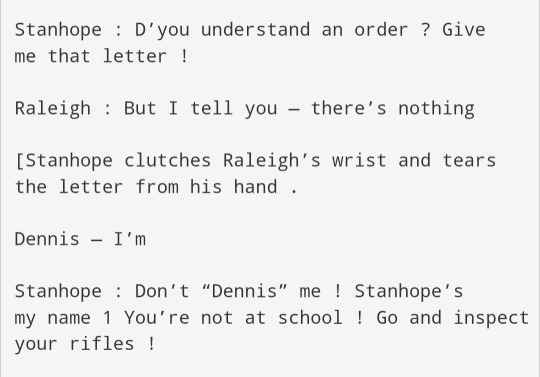
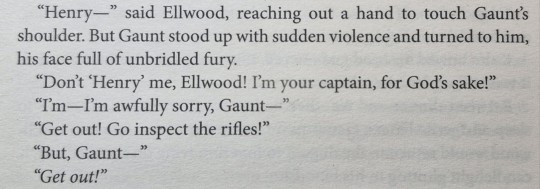
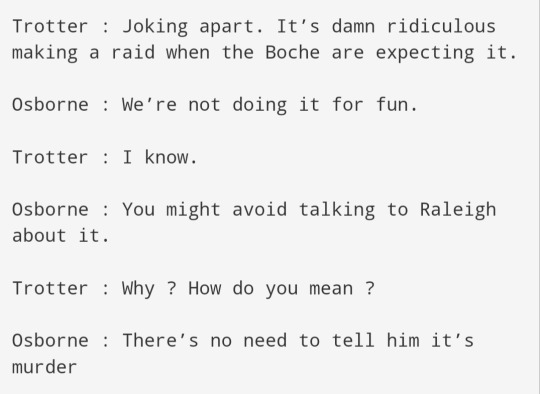

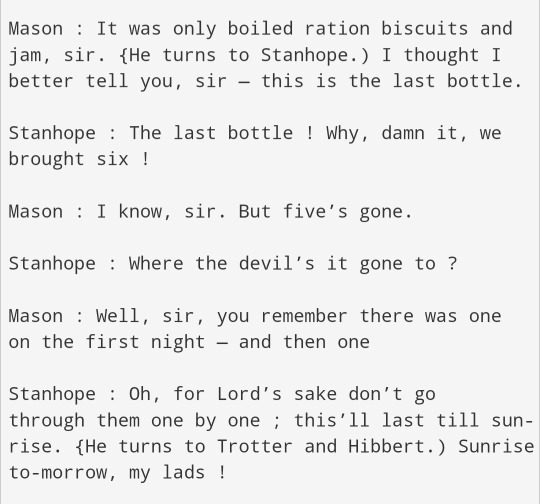

Along with even more likenesses, they also both have a sequence of crossing No man's land to capture a German (the whole time while reading that bit in In Memoriam I was like 'Why do I feel like I've been here before?!?!')
#hayes = osborne. gaunt = stanhope. ellwood = raleigh. change my mind.#just found out stanhope was originally played by laurence olivier?????#so i was just supposed to find that out on my own was i#in memoriam alice winn#in memoriam by alice winn#journeys end
24 notes
·
View notes
Text
Dread by the Decade: The Invisible Man
👻 You can support me on Ko-Fi! ❤️
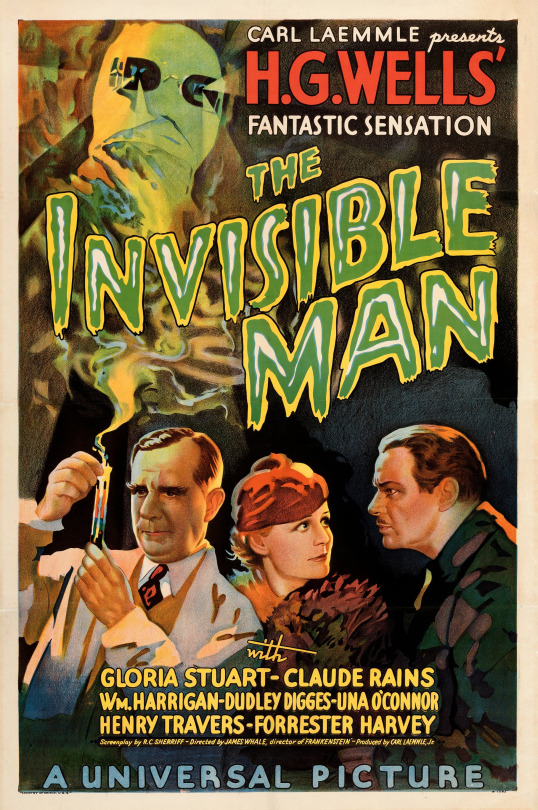
★★★★
Plot: A scientist creates a potion that turns him invisible at the cost of his sanity.
Review: A fun, if occasionally silly, sci-fi horror with an unsettling central concept, exceptional special effects, and memorable set pieces.
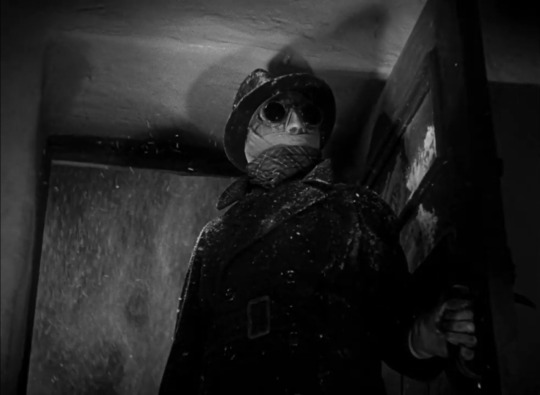
Source Material: The Invisible Man by H. G. Wells Year: 1933 Genre: Sci-Fi Horror Country: United States Language: English Runtime: 1 hour 11 minutes
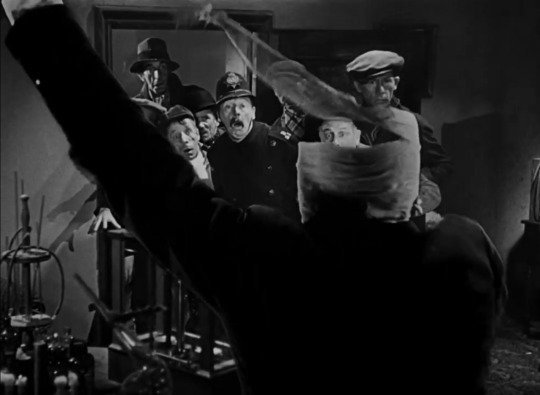
Director: James Whale Writer: R. C. Sherriff Cinematographer: Arthur Edeson Editor: Ted Kent Composer: Heinz Roemheld Cast: Gloria Stuart, Claude Rains, William Harrigan, Henry Travers, Una O'Connor
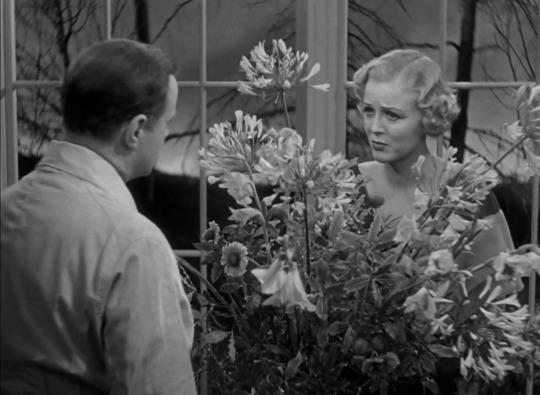
-----
Story: 3.5/5 - Interesting and tense, though some elements feel like they could have been explored more, such as Jack's initial experiments. Some comedic bits also go on for a bit too long.
Performances: 4/5 - Everyone does a very solid job, including Rains, who often has to rely solely on his voice.
Cinematography: 4/5 - Some really clever camerawork when displaying Jack's invisibility.
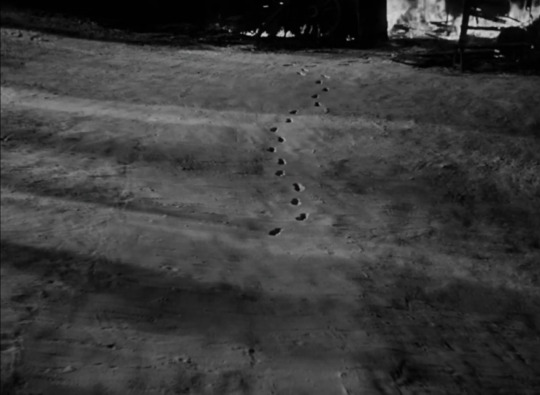
Editing: 3.5/5
Music: 3/5
Effects & Props: 5/5 - Just amazing. Pretty much every scene involving Jack looks remarkable, especially when he's undressing.
Sets: 3.5/5 - Not terribly memorable but they don't really need to be. Well laid out and dressed.
Costumes, Hair, & Make-Up: 4.5/5 - Jack's look as the Invisible Man is deservedly iconic.
youtube
Trigger Warnings:
Mild violence
Brief mention of animal abuse
#The Invisible Man (1933)#The Invisible Man#James Whale#American#Dread by the Decade#review#1930s#★★★★
22 notes
·
View notes
Text

Actors Peter Cushing and Helen Shingler enjoy a relaxing cup of tea between rehearsals for the television play 'Home at Seven' by R. C. Sherriff, 8th August 1956.
18 notes
·
View notes
Text
Sci-Fi Saturday: The Invisible Man

Week 12:
Film(s): The Invisible Man (Dir. James Whale, 1933, USA)
Viewing Format: DVD
Date Watched: August 13, 2021
Rationale for Inclusion:
After a diversion into aeronautic sci-fi and a post-apocalyptic narrative, our survey returns for one last example of a Pre-Code horror hybrid: The Invisible Man (Dir. James Whale, 1933, USA).
As with Island of Lost Souls (Dir. Erle C. Kenton, 1932, USA), The Invisible Man is based on an H.G. Wells novel. Unlike when Paramount Pictures bought the rights to adapt The Island of Dr. Moreau, however, Wells demanded script approval as part of the deal with Universal Studios for them to adapt The Invisible Man. Wells had hated the adaptation of The Island of Dr. Moreau, finding its emphasis on horror and lack of imagination miserable, and was not going to let a similar fate befall another one of his novels.
Although the rights were secured by Universal not long after the success of Dracula in 1931, it would take two years for the studio to assemble a satisfactory crew, script and cast. James Whale signed onto the project in 1931, but after the huge success of Frankenstein (1931, USA) left the project, not wanting to be associated as a horror director. However, after his return to romance with The Impatient Maiden (1932, USA) failed at the boxoffice, Whale returned to horror, first with The Old Dark House (1932, USA), which reunited him with Boris Karloff, and then signing back on to The Invisible Man. During Whale's absence from the project many screenwriters and drafts of screenplays, some of which used elements from another novel that Universal bought the rights to, The Murderer Invisible by Philip Wylie, had come and gone and failed to meet with Wells' approval.
In June of 1933, a script that finally met with Wells' approval was produced by R. C. Sherriff, who had written the play Journey's End, which sent Whale's star on the rise. This screenplay originated the idea that the experimental monocane serum that Dr. Jack Griffin (Claude Rains) produces not only makes him invisible, but slowly destroys his sanity. Similar to the lab setup and lightning power in Whale's Frankenstein, insanity as a byproduct of the invisibility would inform later adaptations of the Wells novel, including the early 2000s television series, which also featured a clip from the 1933 film in its opening credits sequence.
Reactions:
As resistant as Whale initially was to making horror films after Frankenstein, he proved with each subsequent one that he made how good he was at it. With the help of a group of repertory creatives both on and off screen, Whale put a pathos and humor into his horror films in a way that no other director working in the genre in the 1930s did. It's why over 90 years later Frankenstein, The Old Dark House, The Invisible Man, and The Bride of Frankenstein (1935, USA) are some of the best horror films of their era and amongst the most influential of all time.
Yet, the horror genre aspects in The Invisible Man are not as prominent as its science fiction categorization. Griffin is a mad scientist, that is an otherwise average person, whose hubris and curiosity makes a monster out of him. My partner noted that he considers The Invisible Man to definitely be a monster movie, but more of a suspense or mystery film than a horror film. Any movie that features a serial killer is at least partially horror in my reckoning, but the way the narrative of The Invisible Man unfolds, it is closer to a suspense film like M (Dir. Fritz Lang, 1931, Germany) than an unquestioned horror film with a fantasy monster like Dracula (Dir. Tod Browning, 1931), despite all three having narratives that boil down to "what is the mystery surrounding this man" then "this man is a monster and must be destroyed for the greater good."
The mystery and monstrosity around Griffin is rendered possible through the performance of Claude Rains and some inventive special effects. As with Whale's casting of Karloff in Frankenstein, his role as the title character in The Invisible Man was a star-making role for theater actor Rains. Having to rely on his voice and physicality, but not his face, gave Rains some trouble during production, but he ultimately created a character that oscillates between aloofly mysterious and a madcap lunatic.
A combination of post-production optical work, clever blocking, and use of wires rendered Griffin invisible. The special effects used would remain the standard way of conveying an invisible entity prior to computer generated imagery and post-production work becoming dominant in the industry. As silly as it may feel knowing that Griffin unwraps his head revealing nothing beneath is achieved by something as simple as Rains wearing his shirt and jacket above his head as he removes the bandages it remains visually iconic.
My only issue with the practical special effects comes at the film's climax when Griffin exits the cabin where he is hiding out and he leaves shoe prints in the snow, despite it being previously established that to be fully invisible (as he is in the scene) he must be totally naked. What baffles me if the use of shoe prints instead of footprints was a question of deliberate censorship or thoughtless oversight. I usually don't get nitpicky about these types of goofs in movies, but it stands out sharply in an otherwise carefully engineered film.
6 notes
·
View notes
Text
What I Read in 2024
I read 44 books in 2024.
I did not meet any of my 2023 goals - I read no Spanish language picture books, no poetry, no translated books, and did not finish any books by Sudanese, Ukranian, or Palestinian authors.
For 2025, my goal is to fall in love with reading again! I think downloading my library's SimplyE app is going to help--now I'm not locked into borrowing only Kindle books or hard copies.
Highlights of 2024 reading include the newest KJ Charles novel and T. Kingfisher's latest Paladin book (Shane, my beloved). A friend introduced my to Joanna Lowell's work (historical romance featuring lady fine artists! heck yes!). I also enjoyed learning more about Edith Hamilton (pour one out for when 'public intellectual' was an actual career path, seriously).
What did you read and enjoy this year?
My full list below the cut:
Romance
Romancing Mister Bridgerton by Julia Quinn
A Nobleman's Guide to Seducing a Scoundrel by KJ Charles
The Lily of Ludgate Hill by Mimi Matthews
Astrid Parker Doesn't Fail by Ashley Herring Blake
Diamond Ring by K. D. Casey
For Her Consideration by Amy Spaulding
The Hate Project by Kris Ripper
To Marry and To Meddle by Martha Waters
The Duke at Hazard by KJ Charles
The Lawrence Browne Affair by Cat Sebastian
The Ruin of a Rake by Cat Sebastian
10 Things That Never Happened by Alexis Hall
Pansies by Alexis Hall
For Real by Alexis Hall
Waiting for the Flood by Alexis Hall
A Shore Thing by Joanna Lowell
The Duke Undone by Joanna Lowell
Mystery
Murder on Black Swan Lane by Andrea Penrose
Murder at Kensington Palace by Andrea Penrose
The Late Mrs. Willoughby by Claudia Gray
Lavender House by Lev AC Rosen
The Bell in the Fog by Lev AC Rosen
YA
Travelers Along the Way by Aminah Mae Safi
Fantasy / Sci Fi
Legends and Lattes by Travis Baldtree
The Ladies of Mandrigyn by Barbara Hambly
Witchmark by C. L. Polk
Stormsong by C. L. Polk
Soulstar by C. L. Polk
Wolfsong by TJ Klune
Ravensong by TJ Klune
The Hopkins Manuscript by R. C. Sherriff
Paladin's Hope by T. Kingfisher
Paladin's Grace by T. Kingfisher
Paladin's Strength by T. Kingfisher
Paladin's Faith by T. Kingfisher
Swordcrossed by Freya Marske
Historical Fiction
All the World Beside by Garrard Conley
Nonfiction
Ask a Queer Chick: A Guide to Sex, Love, and Life for Girls Who Dig Girls by Lindsay King-Miller
Come Together: The Science (and Art!) of Creating Lasting Sexual Connections by Emily Nagoski
American Classicist: The Life and Loves of Edith Hamilton by Victoria Houseman
A Year's Turning by Michael Viney
The Race to be Myself by Caster Semenya
A Naturalist Buys an Old Farm by Edwin Way Teale
Your House in the County by Henry and Eugenia Mins
1 note
·
View note
Text
ooo- tagged by @mr-1-2-3-4 thank you!
Last song: And I Love Her by The Beatles
Favourite colour: Green or pink I think
Last book: Journey's End by R. C Sherriff; if we're speaking novels then 'The War of the Worlds' by H. G Wells
Last movie: Transformers One
Last TV show: Crash Landing on You
Sweet/Spice/Savoury: Sweet
Relationship status: I have a partner in crime
Last thing googled: 'shadow of moil 5e' (for a DND campaign i'm in lol i'm paranoid)
Current obsession: Shadow Company, Ghostbusters (Batman and Transformers don't count those are ongoing-)
Looking forward to: Playing Mouthwashing ASAP- hopefully Friday night! This game has me EXCITED-
tagss- @lincolnide @zante-selachi @kings-out-of-pocket-hell also any one of my mutuals on here who want to B]]] i see y'all and am nervous to interact
ten people i'd like to get to know better
tagged by: @megkuna thanks <333
last song: the phantom of the opera
favorite color: muted green
last book: uhhhhhh oh man i really need to start reading books
last movie: phantom of the opera which i watched with a friend
last tv show: the original star trek which i also watched with a friend
sweet/spicy/savory: sweet, i love sugar too much
relationship status: single and not looking, i'd rather just have more friends
last thing i googled: "how to know if skincare routine is too harsh" my pimples hurt in a Different way now :(
current obsession: probably still mob psycho 100 but it's not what it used to be. yay depression
looking forward to: when my family finally moves into the new house
tagging: @scarecloud69 @disorganised-thoughtss @daneonrainbow @lawful-goof @officialkarinuzumaki @leo-probably @vychodocech @umkayonninay @mocha-blossom @spageddy29 no pressure though <3
3K notes
·
View notes
Text
Early Television History - Broadcasts And Events.
1930: July 14 – For the first time in the United Kingdom, a television drama is broadcast. The drama is a production of Luigi Pirandello's The Man With the Flower in His Mouth; it is broadcast by the BBC from Baird's studios at 133 Long Acre, London.
November 5 – Baird television transmissions at Hairdressing Fair of Fashion include the world's first television commercial for the Eugène Method of permanent hair waving.
December 7 – W1XAV in Boston, Massachusetts broadcasts the first television commercial in the United States, of I.J Fox Furriers during The Fox Trappers.
1934: July 11 - In the U.S., the Communications Act of 1934 stipulates that commercial television stations "operate in the public interest, convenience, and necessity". The Federal Communications Commission (FCC) is charged with the responsibility of enforcing the act.
1937: January 19 – BBC Television broadcasts The Underground Murder Mystery by J. Bissell Thomas from its London station, the first play written for television.
May – Gilbert Seldes becomes the first television critic, with his Atlantic Monthly magazine article, the "Errors of Television".
May 14 – The BBC broadcasts a thirty-minute excerpt of Twelfth Night, the first known instance of a Shakespeare play televised. Among the cast are Peggy Ashcroft and Greer Garson.
November 11 (Armistice Day) – BBC Television devotes the evening to a broadcast of Journey's End by R. C. Sherriff (1928, set on the Western Front (World War I) in 1918), the first full-length television adaptation of a stage play. Reginald Tate plays the lead, Stanhope, a rôle he has performed extensively in the theatre.
November 27 – NBC in the United States broadcasts the first of six live teleplays of The Three Garridebs (based closely on Arthur Conan Doyle's story "The Adventure of the Three Garridebs"), the first known television pilot, in which Louis Hector becomes the first actor to play Sherlock Holmes on television.
1938: February 11 – BBC Television in England broadcasts the first ever television science-fiction, a 35-minute adaptation of a segment of the play R.U.R. by the Czech playwright Karel Čapek.
May 14 – The first quiz show, Spelling Bee, is televised by the BBC.
June 7 – An excerpt from Susan and God is the first Broadway play with its original cast to be broadcast on television. Station W2XBS uses exact replicas of the stage sets, with Nancy Coleman, Gertrude Lawrence and Paul McGrath appearing on the broadcast.
November – Due to freak atmospheric conditions, a BBC TV broadcast from London is received in New York City. A film camera was used to record the silent images which included the performance of a play, a cartoon, and other matter. A four-minute excerpt from this filmed recording survives and is, as of 2014, considered the only surviving example of a pre-war BBC television transmission.
November 12 - NBC's W2XBS broadcasts what is the first telecast of an unscheduled event, a fire on Wards Island near Manhattan.
1939: March 4 – The BBC Television Service broadcasts one of the first television plays specially written for the medium, Condemned To Be Shot by R. E. J. Brooke, live from its London studios at Alexandra Palace. The production is notable for the use of a camera as the first-person perspective of the play's unseen main character.
March 27 – The BBC broadcasts the entirety of Magyar Melody live from His Majesty's Theatre in London. The 175-minute broadcast is the first showing of a full-length musical by television.
April 30 – Franklin D. Roosevelt, appearing at the opening ceremony of the 1939 New York World's Fair, becomes the first President of the United States to give a speech that is broadcast by television.
May 3 – The Walt Disney cartoon Donald's Cousin Gus airs on NBC's experimental station W2XBS (later WNBC-TV) in New York. This marks the first movie cartoon to be televised in the United States.
November 23 – The earliest known live telecast of the Macy's Thanksgiving Day Parade is broadcast locally in New York.
0 notes
Text

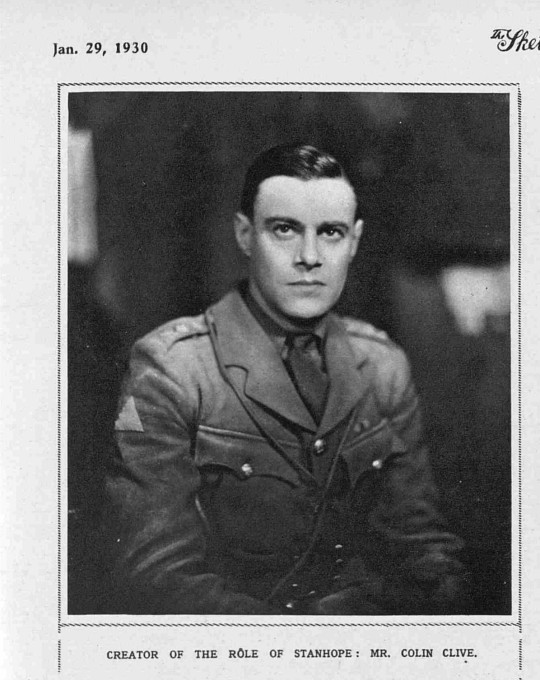


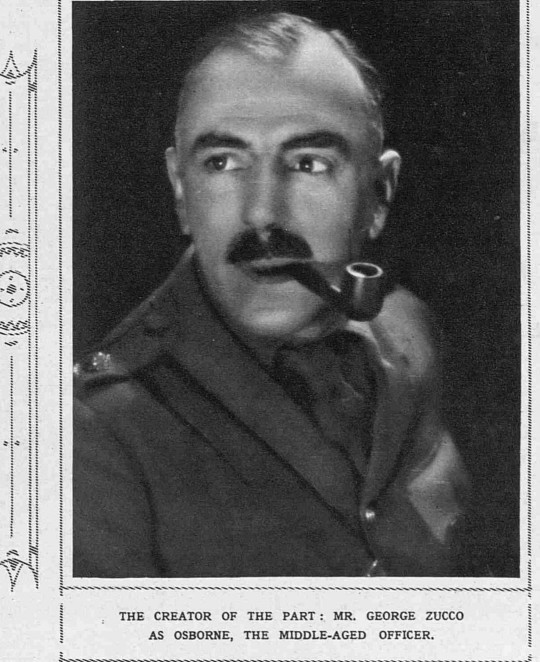
Here is a bit more information, and some very nice cast photos, from the anniversary performance of Journey's End. From The Sketch, published January 29, 1930.
It's probably hard to read the text below the pictures, so here's a transcript:
"ONE OF ENGLAND'S CHIEF EXPORTS!": "JOURNEY'S END" PERSONALITIES.
"Journey's End" celebrated the anniversary of its production last week, when, after attending the performance at the Prince of Wales's, a distinguished company sat down to supper in a fair imitation of a dug-out such as is represented on the stage. Miss Ellen Wilkinson, who was pointed out as the person to whom the play owes most, in that she introduced the "benevolent millionaire" who put up the money, made a speech, and mentioned that Mr. Sherriff's famous play, and coal, were England's chief exports! Mr. Colin Clive, the creator of the part of Captain Stanhope, also spoke, as did the original Mason, who is still playing his role--though his speech was confined to the repetition of his well-known "'Ave a nice cup o' tea, Sir," with which he chipped in whenever Mr. Clive paused!
Portrait No. 1 by Pollard Crowther, F.R.P.S., and other Camera Portraits by Paul Tanqueray
#Journey's End#Colin Clive#Robin Irvine#Alexander Field#George Zucco#1930#Ellen Wilkinson#R. C. Sherriff#mason is mrs. doyle confirmed
29 notes
·
View notes
Video
youtube
via MTV International // Asa Butterfield, Sam Claflin & Tom Sturridge talking about their upcoming film #JourneysEnd! They also discuss the life on set!
#asa butterfield#sam claflin#paul bettany#tom sturridge#stephen graham#toby jones#journey's end#world war one#ww1 drama#r. c. sherriff#based on a play#upcoming#mtv#mtv international#interview#updates#news#youtube#video#link
39 notes
·
View notes
Text
Julien Blanc, « Le Manuscrit Hopkins, roman, par R. C. Sherriff (Pion) », La NRF, n° 329, juillet 1941, p. 124
Julien Blanc, « Le Manuscrit Hopkins, roman, par R. C. Sherriff (Pion) », La NRF, n° 329, juillet 1941, p. 124


https://julienblancromancier.wordpress.com/articles-de-j-blanc/
View On WordPress
0 notes
Note
theme..pining?

Velimir Khlebnikov, My Darling

Federico García Lorca, Prelude (trans. Martin Sorrell)

Richard Jackson, Basic Algebra

Camille Norton, Corruption Poems

Sierra DeMulder, Your Love Finds Its Way Back
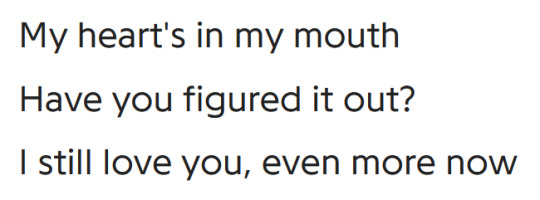
Scouting for Girls, Butterflies

Walt Whitman, Leaves of Grass

Anne Sexton, Small Wire

Olivia Gatwood, The Lover as a Cult

Nina LaCour, We Are Okay

Annelyse Gelman, The Pillowcase

Vladimir Nabokov, Letters to Vera

Anis Mojgani, In the Pockets of Small Gods

R. C. Sherriff, Journey’s End

Frank O’Hara, Having a Coke with You
#webs#web weaving#theme: love#theme: wanting to be wanted#theme: want#theme: desire#theme: yearning#requests#mine#velimir khlebnikov#federico garcía lorca#richard jackson#camille norton#sierra demulder#scouting for girls#walt whitman#anne sexton#olivia gatwood#nina lacour#annelyse gelman#anis mojgani#r. c. sherriff#frank o'hara#vladmir nabokov#faves
3K notes
·
View notes
Photo
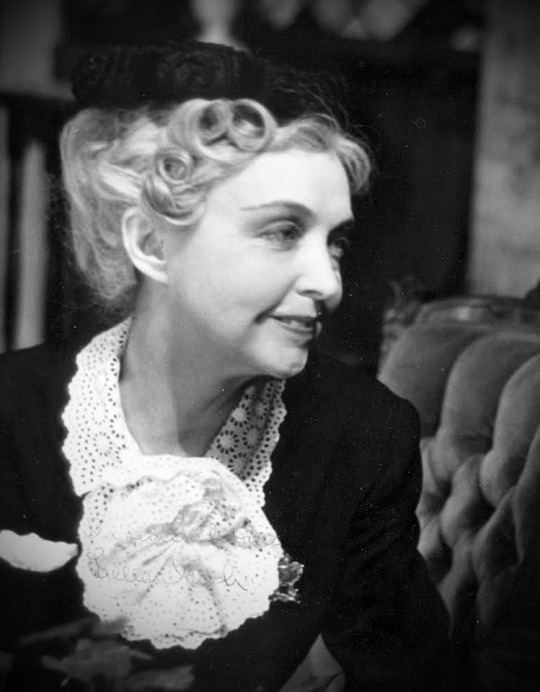
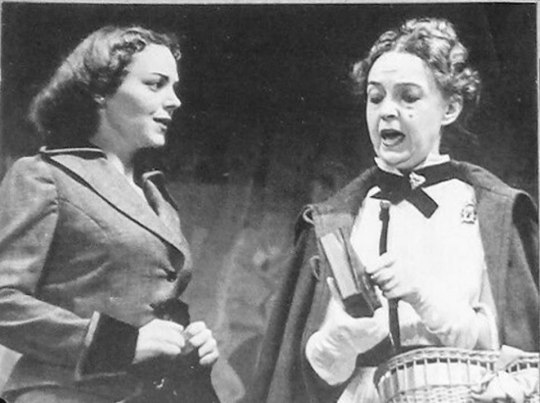

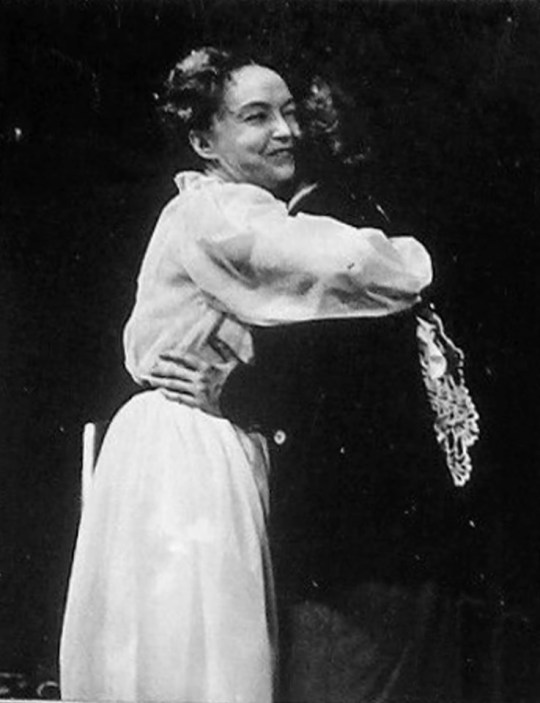


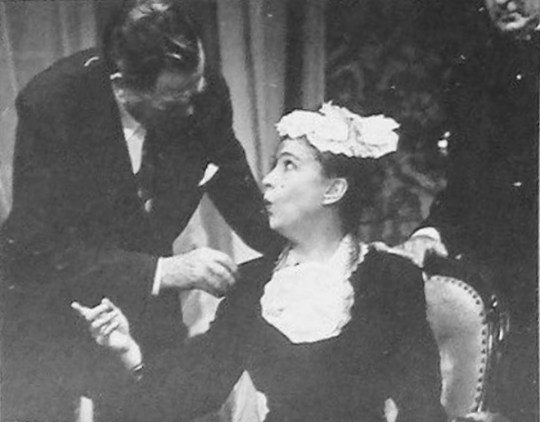
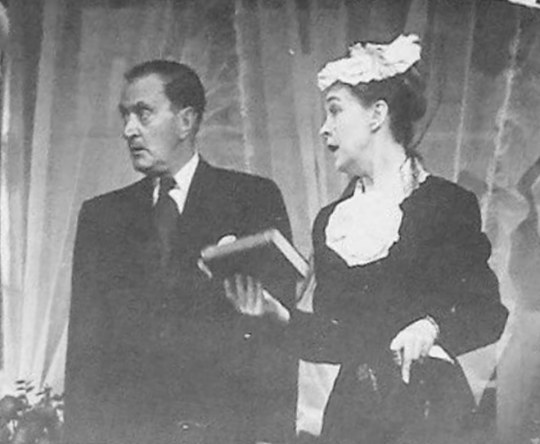
Miss Mabel (1950)
Miss Mabel is a 1948 stage play by R. C. Sherriff. It has been adapted for television at least five times.
1950 – A play in three acts, produced by Joel Shenker as a summer theatre touring package.
Advance director: Jerome Coray
With Charles Francis, Wallace Clark, Mark Roberts, Harry Bannister, Victor Beecroft, Gwen Anderson, Marie Carroll, Bethel Long.
Subsequent cast changes throughout tour as well as resident actors playing different roles in each theatre (Dorothy and Lillian Gish by Lillian Gish)
Also, a live version aired as part of British anthology series BBC Sunday Night Theatre in 1950. Cast included Mary Jerrold, Clive Morton, Richard Warner, W. E. Holloway, Josephine Middleton, Herbert C. Walton, Anne West, Ronald Marriott, Rowland Winterton and Anthony Farmer. It was performed on 26 March 1950 with a repeat performance on 29 March 1950. Both performances are lost, as the live broadcasts were not recorded.
Rehearsals for Miss Mabel went smoothly, once we learned to anticipate interruptions over which we had no control, like the noise and whistling from the trains. We had an idea of their schedule, so we could time when we were going to have our words drowned during matinees and evening. Whoever was talking would just remain in place and not say a word until the train had passed. Clarence Derwent, for all his impressive British training and background, was a very casual actor. He had a very relaxed delivery, and he didn’t like to wear any makeup other than his costume.
Once, on a matinee day, he came to the theatre from a long walk in the woods just before half-hour. He put on his costume and he took his seat on a soft chair onstage as the curtain went up, which he was supposed to do. A few minutes into the performance, he fell asleep.
The audience didn’t know what was happening, but onstage, including Lillian, did. Clarence wasn’t snoring. He had leaned back and closed his eyes.
Lillian looked over in his direction, and very casually, during the course of the scene, tiptoed behind the chair where Clarence was sitting. She placed her hand on his shoulder leaned over, and blew on his neck!
She might have whispered something which only he could have heard, but Clarence opened his eyes and said his line as if the action were rehearsed!
Whether she gave him a dressing down afterwards we never knew. But he never took any morning walks on a matinee day. And he never closed his eyes in that chair for the rest of the run!
When Miss Mabel company flew to the Bahamas to play an engagement at the Royal Colonial Theatre, Lillian made a star’s demand: to allow Malcolm, her West Highland terrier who had been with her since The Old Maid (1936), to ride next to her on the plane.
Lillian Gish: A Life on Stage and Screen – Stuart Oderman
9 notes
·
View notes
Text
Dread by the Decade: The Old Dark House
👻 You can support me on Ko-fi ❤️
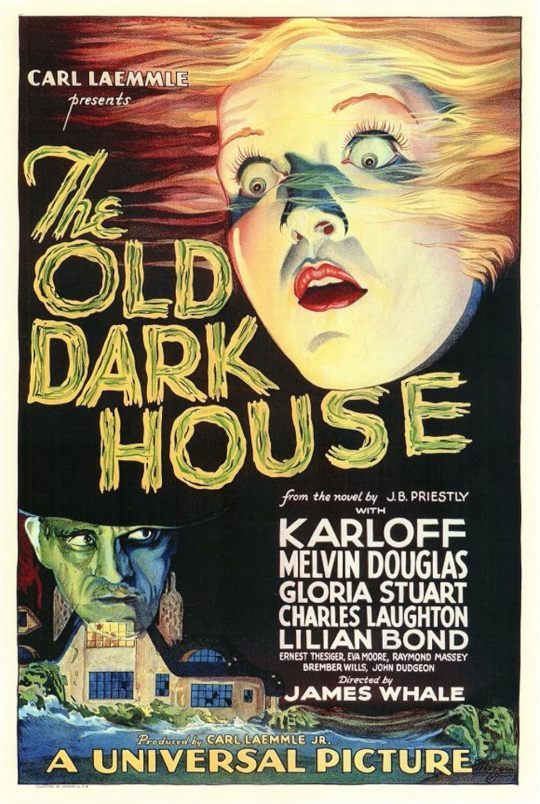
★★★½
Plot: Travelers shelter from a storm in an eccentric family's manor.
Review: A bizarre, silly tale sustained by its charming cast and striking cinematography.
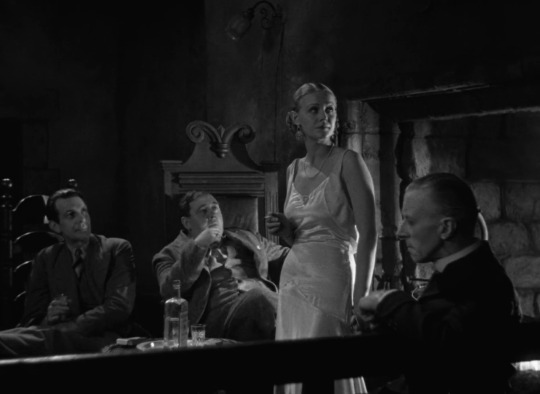
Source Material: Benighted by J. B. Priestley Year: 1932 Genre: Horror Comedy, Gothic Country: United States Language: English Runtime: 1 hour 12 minutes
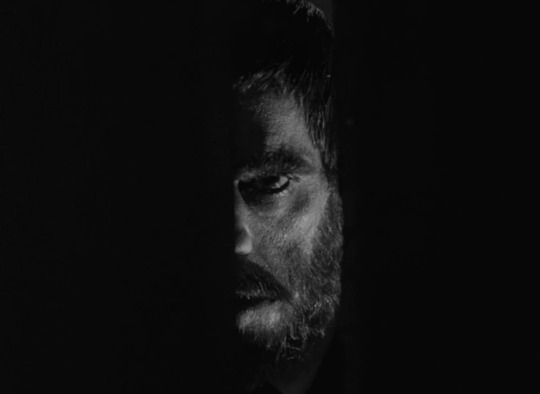
Director: James Whale Writers: Benn W. Levy, R. C. Sherriff Cinematographer: Arthur Edeson Editor: Clarence Kolster Composer: David Broekman Cast: Melvyn Douglas, Raymond Massey, Ernest Thesiger, Gloria Stuart, Charles Laughton, Lilian Bond, Eva Moore, Boris Karloff
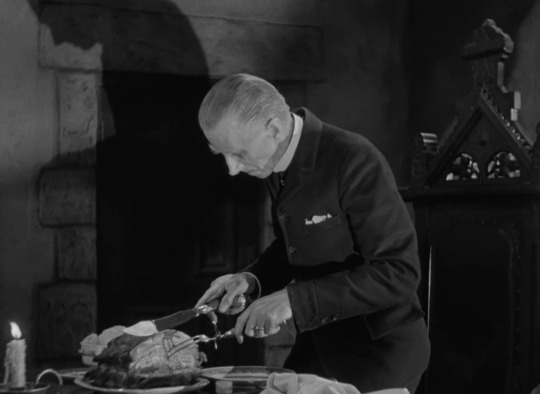
------
Story: 3.5/5 - Successfully pokes fun at gothic horror tropes and cliches, but suffers slightly from a rushed ending.
Performances: 4/5 - The cast do a great job playing exaggerated gothic stock characters, from Laughton's campy aristocrat to Eva Moore's overly-ominous lady of the manor.
Cinematography: 4/5 - Excellent framing.
Editing: 4/5
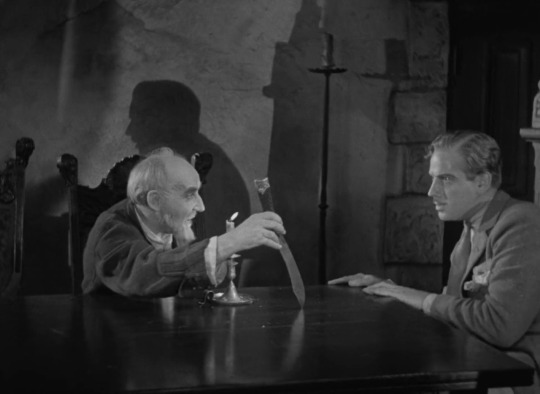
Music: 3.5/5
Effects: 4/5 - The car crash and landslide are a bit silly, but fit the tone of the film.
Sets: 4/5 - Well-dressed sets with eerie hallways and stairwells. A bit disappointing there isn't a wide shot of the manor itself, though.
Costumes, Hair, & Make-Up: 4/5 - Solid. A surprise character towards the end sports interesting make-up.
youtube
Trigger Warnings:
Mild violence
Alcoholism
Domestic abuse (off-screen)
#The Old Dark House (1932)#The Old Dark House#James Whale#American#horror comedy#psychological horror#Dread by the Decade#review#1930s#★★★½
11 notes
·
View notes